Why Graphics Don’t Matter (As Much As You Think)
For gamers, visuals have always been a major selling point.And we’re going to discuss further why Graphics Don’t Matter. We’ve witnessed incredible leaps in graphical fidelity over the years, but has the focus on realism overshadowed what truly matters: a game’s art style and core experience?
The argument here is that graphics have plateaued in recent years. While some games boast impressive technical feats, they often lack a distinct visual identity. Games from a decade ago like Dishonored or Bioshock Infinite still hold up remarkably well, proving that art style has a timeless quality.
Why Art Style Wins:
- Longevity: A strong art style transcends generational changes in graphics hardware. Games like Kingdoms of Amalur or Fable remain visually appealing due to their distinct artistic choices.
- Clarity and Immersion: A well-defined art style prioritizes readability and clarity. Details are easier to distinguish, enhancing gameplay and immersion. This is evident in games like DOOM where enemy visibility trumps photorealism for a better gameplay experience.
- World Building: A cohesive art style strengthens a game’s narrative and world-building. Take Overwatch with its Pixar-inspired aesthetic, perfectly capturing the game’s lighthearted tone.
Even with Simple Graphics, a Game Can Shine:
Look at Undertale, a pixelated RPG that took the gaming world by storm. It wasn’t the cutting-edge visuals that captivated players, but the incredibly rich story, memorable characters, and innovative gameplay mechanics. Undertale proves that captivating characters, a compelling narrative, and unique gameplay can elevate a game to legendary status, even with a minimalist visual style. The pixel art in Undertale is charming and effective, perfectly complementing the game’s quirky humor and emotional depth.
The focus on story and character development allows players to connect with the world and its inhabitants on a deeper level, a feat often overshadowed by flashy graphics. Undertale reminds us that the true heart of a game lies not in its visual fidelity, but in its ability to engage us emotionally and intellectually.
The Pitfalls of Focusing on Graphics:
- Generic Visuals: Many modern games prioritize technical prowess over artistic identity, leading to generic and forgettable visuals.
- Diminishing Returns: Beyond a certain point, graphical improvements become less noticeable, offering little impact on the overall experience.
- Sacrificing Visibility: Overly detailed or “realistic” visuals can hinder gameplay by making it difficult to distinguish objects and enemies (e.g., Immortals: Fenyx Rising).
Conclusion
While advancements in graphics technology are undeniably impressive, the pursuit of hyper-realism can sometimes overshadow a game’s true potential. A strong art style, on the other hand, offers a multitude of benefits. It transcends graphical limitations, enhances clarity and immersion, and strengthens a game’s world-building.
Remember, games like Undertale prove that even “simple” graphics can captivate audiences. The focus should be on creating a cohesive and engaging experience, where art style and gameplay work together to create a lasting impression.
So, the next time you’re looking for a new game, don’t just be swayed by flashy graphics. Consider the art style and what kind of atmosphere it creates. After all, it’s the art style, not the raw graphical power, that will truly immerse you in the world and leave you wanting more.

